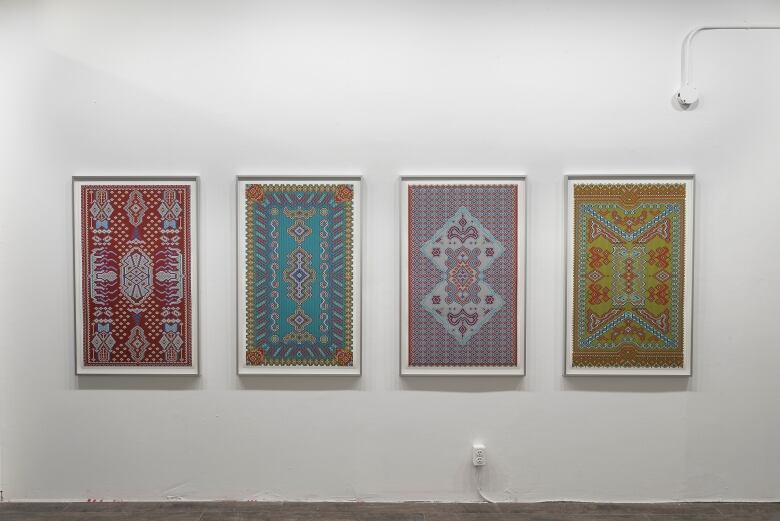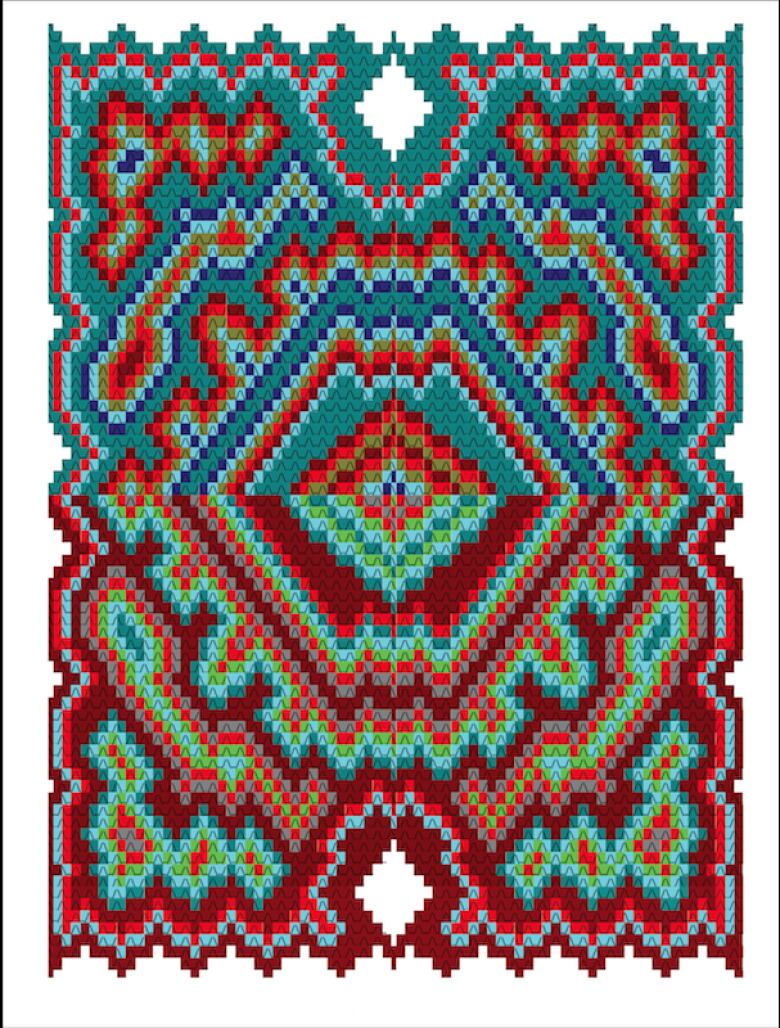How to weave an Afghan rug...using Microsoft Word
File > New > Perspective! Shaheer Zazai discovered a new medium — and a new appreciation for his culture

This sentence was written in Microsoft Word. This whole article was, actually. But Shaheer Zazai uses the granddaddy of desktop publishing to make art, and while there are a few folks out there creating pixel masterpieces in Excel, nobody, not even Clippy, could make this kind of magic in Office Suite.
By completely filling page after page with colour and text, Zazai weaves dense designs that suggest the pattern and texture of ornate Afghan rugs.
Just take a look — and zoom in while you're at it.



Blank document > Create
Zazai's first step is creating a base layer of texture. He'll peck out exclamation marks and slashes, for example, starting from a corner and working outwards. No hidden messages, it turns out — just punctuation.
For colour, he'll select the highlighter tool — working within the confines of 15 system tones. It's dabbed on individual characters, spaced out according to a rigid sequence. Every third character might be eye-searing cyan, for instance.
You never know what can lead you where.- Shaheer Zazai, artist
The work, he says, is completely improvised, and he might spend weeks typing out a rug. The finished product is big enough to be presented as a large-scale print — millions of keystrokes transforming into something that could really tie a room together. Here Now Back Then, a solo exhibition of his word-processed art (including prints, video and a digital book), is on at Toronto's Double Happiness Projects to April 27.
"You never know what can lead you where," says Zazai.
In the beginning, this was never supposed to be an art project. That's just what it's become. His whole process of weaving virtual rugs is slow and meditative, and over time, it unlocked a new perspective on a place he left as a kid.
"The digital work, I avoided putting it out there for a long time because I consider myself a painter," says Zazai, an OCAD U grad who paints out of a Toronto studio. "But for me, at this point, this work has almost become a means of going back to culture."
'Maybe subconsciously the imagery was always there'
Zazai, 32, was born in Afghanistan. "As a family, we moved around," he says. Before reaching Canada, they lived in Pakistan for 13 years. "We moved so many houses and schools, and over this whole time, there's been a detachment that's happened from culture, and our own history."
"But what [this project] has done is taken me full circle and brought me back to understanding culture in a different light," he says.
"It brought me back to looking at culture for what it is — for the beauty of it, for its significance."
"War itself becomes the most prominent thing that you recognize a country by, and that was something that I had in my own perspective for a long time. But now I don't see it that way. I'm more focused on what the country, or what my own culture has to offer — for the good it has to offer, be it culture or the beauty of the culture, the people, the craft that has been around for so long."

Zazai has no personal connection to the craft itself, he says. He's never woven a rug with anything but a keyboard. But the carpets are both the country's most famous export — an instantly recognizable symbol — and also a completely personal reminder of home.
"Family-wise, no matter where we've travelled, we've always had our carpets go with us," he says. "We've had carpets that have travelled with us from Afghanistan to Pakistan and now Canada. It's something that's always been there."
Zazai says he'd always been hesitant about mining his backstory for an art project. "I don't know how to explain it," he says. "There's a sense of people using their own culture toward art-making. That was never the intent."
"In my painting practice, I've taken more of a critique of culture over actually understanding the culture I come from," he says.
War itself becomes the most prominent thing that you recognize a country by, and that was something that I had in my own perspective for a long time. But now I don't see it that way.- Shaheer Zazai, artist
"The intended beginning of the project was never, 'I'm going to make carpet designs,'" he says. "But then it started forming because the designs started going in that direction." A week-long residency at OCAD's Digital Painting Atelier in 2015 is where he first started actively pursuing the idea of producing a "carpet" — a living room-sized, 90 x 44-inch print.
"Maybe subconsciously the imagery was always there. It's only so long before something comes out, and that's one good thing about art as a practice. There's always an element of yourself that starts coming out."

But seriously, why Microsoft Word?
It's a discovery borne of inspiration, and most likely, boredom.
While sitting in front of his computer one day, Zazai says he set himself a challenge. Could he type precisely 2,013 dots and spaces without stopping?
"It was partially a joke to myself," he admits, laughing, "but at the same time, it was a test to see whether I'm able."
So he did it, no sweat, and what he saw on the page was potential. Add some colour, and a pattern would naturally appear in the mess of dots — something that looked just like the grid-based designs of woven textiles.
Over time, those patterns wound up triggering a connection to the patterns found on Afghan rugs — but his process, even now, is meditative and completely improvised. The designs are also completely his own. They're not meant to directly copy traditional rug patterns, though they mimic certain elements — they usually feature a border, for example, and a central motif.
Filling a page, he says, can take five to six hours. Completing a piece, which brings multiple pages together in a large-scale print, could require 40 hours. "All I'm really focused on is counting characters: up, down, two down, two right, which colour. That's the limit of what's going on in my head," he says.
"When I first started, a friend at the time told me, 'If you do this for another week, I'll officially consider you crazy.' And here I am five years later and I'm still doing it."
The end goal? Give back
What's especially nuts to consider is the fact that Zazai refuses to copy/paste anything. He draws out the process on purpose, typing every character one by one. There's a message there — one that ties back to the digital nature of the work.
"Technology often gives us shortcuts, and we live in a time when attention spans are short," he says. "But taking the labour-intensive route has a life lesson along with it, and I think that's more important."
Beyond that, it's his way of honouring the IRL artform. "I am taking something from an existing craft. How do I give back? And the only way I could give back was that I have to ethically put as much time as it would take," says Zazai, who is exploring other ways of paying respect to traditional artisans. At Double Happiness Projects, for instance, one of the pieces appearing in the show is a wool rug , which was woven by in Afghanistan according to one of Zazai's designs (Carpet No. 1).

"The one end goal that I've seen for this project is to give back," he says. "Give back to families whose lives have depended on carpet-making who've been affected by war or existing turmoils that are in these war-torn countries. Specifically Afghanistan because I am from there, but who knows where this project is going to go from this point on?"
Keep typing
In the meantime, he'll keep typing. "I have always believed that every idea has its own medium," he says. "And for this Microsoft Word series, that's what it was."
"As soon as someone finds out that [the work] is Microsoft Word, it becomes that much more exciting. It's hard to imagine," he says.
"This project is a great lesson for me. You never know where something could lead you to. One should always leave themselves open — to anything."
Get a closer look at more of his work...






Shaheer Zazai. Here Now Back Then. To April 27 at Double Happiness Projects, Toronto. www.doublehappinessprojects.com

